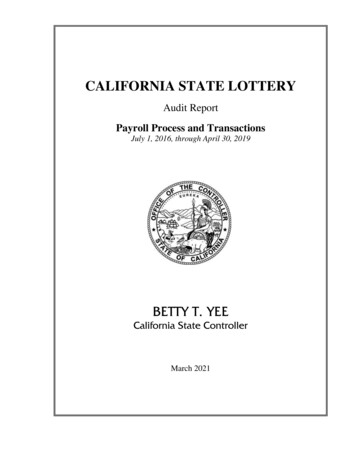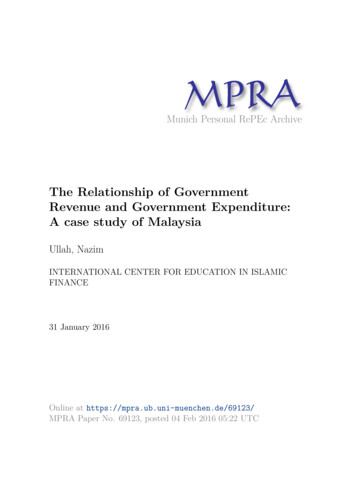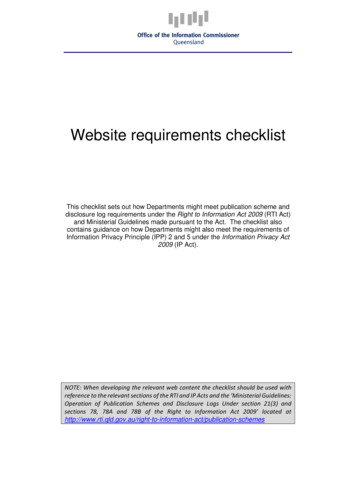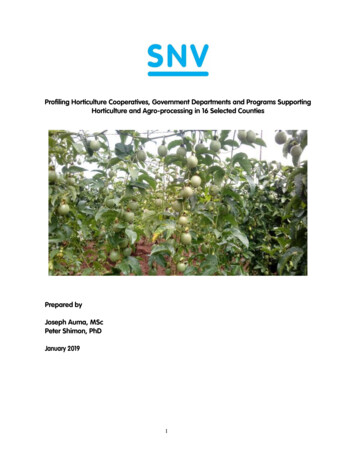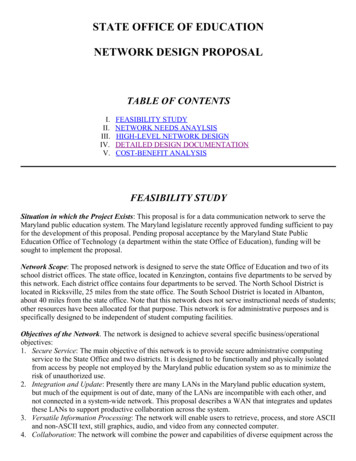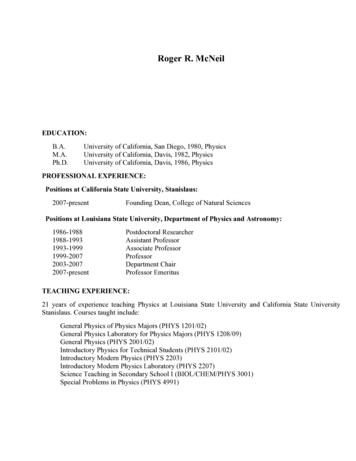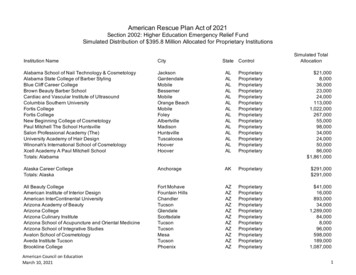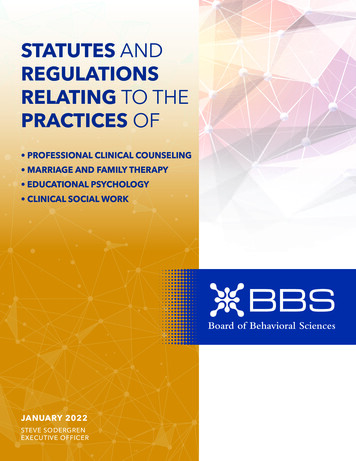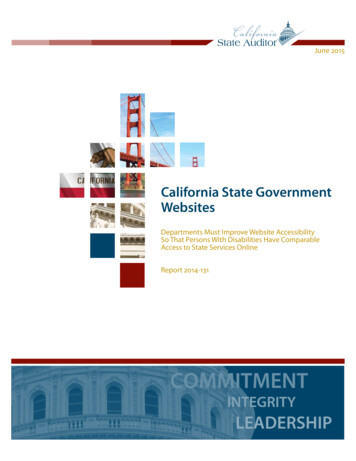
Transcription
June 2015California State GovernmentWebsitesDepartments Must Improve Website AccessibilitySo That Persons With Disabilities Have ComparableAccess to State Services OnlineReport 2014-131COMMITMENTINTEGRITYLEADERSHIP
The first five copies of each California State Auditor report are free. Additional copies are 3 each, payable by checkor money order. You can obtain reports by contacting the California State Auditor’s Office at the following address:California State Auditor621 Capitol Mall, Suite 1200Sacramento, California 95814916.445.0255 or TTY 916.445.0033ORThis report is also available on our website at www.auditor.ca.gov in PDF and HTML formats.Alternate format reports available upon request.The California State Auditor is pleased to announce the availability of an online subscription service.For information on how to subscribe, visit our website at www.auditor.ca.gov.Permission is granted to reproduce reports.For questions regarding the contents of this report,please contact Margarita Fernández, Chief of Public Affairs, at 916.445.0255.For complaints of state employee misconduct, contact the California State Auditor’sWhistleblower Hotline: 1.800.952.5665.
Elaine M. Howle State AuditorDoug Cordiner Chief DeputyJune 2, 20152014-131The Governor of CaliforniaPresident pro Tempore of the SenateSpeaker of the AssemblyState CapitolSacramento, California 95814Dear Governor and Legislative Leaders:As requested by the Joint Legislative Audit Committee, the California State Auditor presents this audit reportconcerning the State’s compliance with federal and state web accessibility standards. Since January 2003,state law has required state governmental entities to comply with federal requirements that mandate thatpersons with disabilities have access to and use of information and data that is comparable to the access anduse by those without disabilities. In addition to adopting the federal standards in 2003, California added newstandards for accessible websites in June 2006. In 2013, the Public Policy Institute of California reported that47 percent of Californians said they use the Internet to access government resources. In addition, data onthe California state government home page showed that in January 2015 there were millions of unique visits toCalifornia government websites.Despite the growing use of government services online and the State’s accessibility requirements, the departments’websites we reviewed during this audit are not fully accessible to persons with disabilities. Although the violationsof web accessibility standards ranged in severity, some of them are so severe that elements of the departments’websites were completely inaccessible to users with disabilities while other violations may prevent persons withdisabilities from completing tasks necessary to access certain online services. For example, we found that, at thetime of our review, persons with disabilities who navigate the Internet using a keyboard would not be able to startan online application for health insurance using Covered California’s website.Most of the departments we reviewed did not regularly test updates to their websites to ensure that the websiteswere accessible after the updates. Of the four departments we reviewed, only Franchise Tax Board conductedregular accessibility testing on updates to its website. In some cases when departments did not thoroughlytest updates to their websites for accessibility, we found critical accessibility errors on updated portions of thedepartments’ websites.Because of the violations of accessibility standards on the websites of the departments we reviewed and the lack ofregular accessibility testing at most of those departments, we believe that California would benefit from requiringweb accessibility training for staff involved in the procurement or development of websites and from naming theCalifornia Department of Technology (CalTech) as the department responsible for overseeing governmental entities’efforts to test their websites for accessibility. Additionally, we believe CalTech should provide direction to statedepartments that specifies the method by which departments should conduct web accessibility testing. Increasedand standardized web accessibility testing in combination with required training would increase the likelihood thatstate websites would be accessible to persons with disabilities who attempt to access critical services and informationthrough those websites. Finally, we recommend that the Legislature amend state law to require all state websites tocomply with updated standards that could help make California government websites more accessible.Respectfully submitted,ELAINE M. HOWLE, CPAState Auditor621 Capitol Mall, Suite 1200S a c r a m e n t o, C A 9 5 8 1 4916.445.0255916.327.0019 faxw w w. a u d i t o r. c a . g o v
Blank page inserted for reproduction purposes only.
California State Auditor Report 2014-131June 2015ContentsSummary1Introduction7Chapter 1Department Websites Do Not Fully Comply With StateAccessibility Standards19Recommendations34Chapter 2Departments Have Not Consistently Tested for Accessibility, andStatewide Web Accessibility Training Should Be Required37Recommendations55Responses to the AuditCalifornia Community Colleges59California State Auditor’s Comment on the ResponseFrom California Community Colleges61California Government Operations Agency, California Departmentof Human Resources63California Government Operations Agency, California Departmentof Technology67California State Auditor’s Comments on the ResponseFrom the California Department of TechnologyCovered CaliforniaCalifornia State Auditor’s Comments on the ResponseFrom Covered CaliforniaCalifornia Government Operations Agency, State of CaliforniaFranchise Tax BoardCalifornia State Auditor’s Comments on the ResponseFrom the State of California Franchise Tax Board7173777983v
viCalifornia State Auditor Report 2014-131June 2015Blank page inserted for reproduction purposes only.
California State Auditor Report 2014-131June 2015SummaryResults in BriefAudit Highlights . . .A significant number of Californians use the Internet to obtaininformation about and avail themselves of government services.According to a 2013 report by the Public Policy Institute ofCalifornia, 47 percent of Californians report they use the Internetto access government services, an increase of 4 percentagepoints from 2008. Also, data featured on the California stategovernment home page showed that in January 2015 there weremillions of unique visits to California government websites suchas the California Department of Motor Vehicles and EmploymentDevelopment Department sites.Our review of the accessibility of key onlineservices offered by four departments—California Community Colleges (CommunityColleges), California Department of HumanResources (CalHR), Covered California, andState of California Franchise Tax Board(Franchise Tax Board)—highlighted thefollowing issues:To ensure access to online government services for persons withdisabilities, California has adopted standards that address theneeds of users who may have one or more of a range of disabilities,including those with visual impairments, hearing impairments,and impairments to mobility. Since January 2003 state law hasrequired California websites to meet requirements stemmingfrom Section 508 of the federal Rehabilitation Act of 1973, asamended (Section 508). Subsequently, in July 2006, Californiaadded the World Wide Web Consortium’s (W3C) Web ContentAccessibility Guidelines (WCAG) version 1.0 as additional stateweb accessibility standards for departments that report to thegovernor and the state chief information officer.Despite the growing use of government services online and theState’s accessibility requirements, the California governmentwebsites we reviewed during this audit are not fully accessible.We reviewed one key online service offered by each of fourdepartments—California Community Colleges (CommunityColleges), California Department of Human Resources (CalHR),Covered California, and State of California Franchise Tax Board(Franchise Tax Board)—to determine whether their online servicesand the associated portions of their websites complied with theState’s accessibility requirements.1 We found violations of applicableaccessibility standards on each department’s website.2 Among thefour departments we reviewed, Covered California’s website hasthe largest number of violations of web accessibility standards.Although the violations we found ranged in severity, many ofthem are critical, meaning that they are severe enough to makeelements of the websites inaccessible to persons with disabilities.1Throughout this report, we refer to each of these state government entities as departments.2For the purposes of this report, we use the term violation to mean noncompliance with anaccessibility standard a department’s website was expected to conform to because of state lawor a grant or contract agreement.»» Despite the growing use of governmentservices online and the State’saccessibility requirements, the Californiawebsites we reviewed are not fullyaccessible to persons with disabilities.»» Some of the accessibility violations are sosevere that, under certain circumstances,they may prevent persons with disabilitiesfrom accessing online services. A CalHR online job exam did notappropriately label the exam questions—persons using screen readers wouldhave had to leave the exam questionresponse area and use other methods todetermine what information to enter. At Franchise Tax Board, users whocannot use a computer mousecannot register an online account forsubmitting tax returns. At Community Colleges, screen readerusers were not alerted that they wouldnot be able to register for an accountif they took too long to completeindividual registration pages. At Covered California, users whocannot use a computer mouse couldnot start an application for healthinsurance because the button on theCovered California website that beginsthe application process could not beaccessed using only the keyboard.continued on next page . . .1
2California State Auditor Report 2014-131June 2015»» At the start of our audit, mostdepartments did not provide informationon their websites to the public abouthow to complain about websiteaccessibility problems.»» Three of the four departments wereviewed could improve the type andfrequency of accessibility testing thatthey perform on updates to theironline services.»» Best practice guidance suggests thatdepartments provide specific training onweb accessibility to staff involved in thedevelopment of websites and web‑basedservices; however, there is no statewiderequirement for such training.»» Although updated standards areavailable that could help California makeits websites more accessible, the State hasnot adopted them.For example, one such critical violation was on a CalHR online jobexam. Users who employ screen reader software—software thatreads web pages aloud to those who cannot read text—should beable to have exam questions read to them as they navigate throughthe exam. However, because CalHR did not appropriately label theexam questions, persons using screen readers would have had toleave the exam question response area and use other methods, suchas browsing the surrounding text on the web page line by line withthe keyboard’s arrow keys, to try to determine what informationthey should enter.Some of the critical accessibility violations we identified are sosevere that, under certain circumstances, they may prevent personswith disabilities from completing the core tasks necessary to accessonline services. These violations occurred at three departments andwould affect users with a variety of disabilities, including motordisabilities and vision loss. A violation on Franchise Tax Board’swebsite prevents users who cannot use a computer mouse fromregistering an online account—a required step in submitting taxreturns online through the department’s CalFile service. In addition,a violation on Community Colleges’ online application for collegeprevented screen reader users who were applying to college onlinefrom registering for an account if they took too long to completeindividual registration pages. This occurred because the notificationthat alerted users that their time to complete the page was almostexpired was not programmed correctly, meaning that the screenreader software did not identify the notification when it appeared.Because these users were not made aware of this notification box,they were unable to request additional time to complete the pageand would be logged off without warning at the expiration ofthe allotted time. The user would then need to start the accountcreation process over again from the beginning. CommunityColleges was made aware of this issue through a complaint from auser in February 2015 and has now resolved the problem. Finally, atCovered California, users who cannot use a computer mouse couldnot start an application for health insurance because the button onthe Covered California website that begins the application processcould not be accessed using only the keyboard.Further, updated standards are available that could helpCalifornia make its websites more accessible. In 2008, shortlyafter California adopted the first version of the WCAG standards,WCAG 1.0, the W3C issued WCAG 2.0. When it did so, the W3Cstated that the WCAG 2.0 standards apply more broadly to differenttypes of web technologies and allow for more effective testing ofwebsites’ accessibility. However, California has not adopted theseupdated standards. In light of these improvements, it is importantthat the Legislature amend state law to require departments tomeet the WCAG 2.0 standards. Further, it is important for the
California State Auditor Report 2014-131June 2015California Department of Technology (CalTech) to monitor commonlyaccepted accessibility standards going forward to help ensure thatCalifornia’s standards do not again become outdated in the future.Most of the departments we reviewed could improve the type andfrequency of accessibility testing that they perform on updates totheir online services. Three of the four departments we reviewed—Community Colleges, Covered California, and CalHR—conductedsome accessibility testing on their websites before initially releasingthe sites to the public. However, best practice guidance suggeststhat departments test updates to their websites as well, using bothautomated and manual techniques. Only Franchise Tax Boardperformed update tests on its website updates in this manner.At the start of our audit, most of the departments we reviewed didnot provide important information on their websites to the publicabout how to complain about website accessibility problems. Statepolicy requires departments to provide users who may want tocomplain about website accessibility with multiple forms of contactinformation, such as an email address, phone number, and mailingaddress. However, at the start of our audit Franchise Tax Board hadfailed to publish an email address on its website. Since then, it hasadded the required information. Although Covered Californiais not required to comply with policies issued by the state chiefinformation officer, who is the director of CalTech, and it is unclearwhether Community Colleges must comply with those policies, weassessed the complaint contact information on both departments’websites against the requirements that other departments mustfollow. At the time of our review, neither department provided onits website all of the complaint contact information that state policyrequires other departments to provide. When departments do notprovide multiple forms of contact information, the risk increases thatusers will be unable to complain about web accessibility problemsthey may encounter so that departments can fix those issues.Similar to the reported level of complaints received by federaldepartments, the departments we reviewed appear to receive veryfew complaints about the accessibility of their websites. In 2010 and2011 the U.S. Department of Justice surveyed 89 federal agenciesabout their compliance with Section 508. In their responses tothe survey, those agencies reported that, from June 2001 through2010, they had received a total of 140 administrative complaintsabout their web accessibility, or only about 15 complaintsper year among all of the agencies. Similarly, we identified noweb accessibility complaints received at Covered Californiasince June 2013, no complaints at Franchise Tax Board since2010, and only five complaints Community Colleges receivedsince November 2012. Most of the complaints we reviewed atCommunity Colleges related to problems that screen reader3
4California State Auditor Report 2014-131June 2015users had with the online application to college. However, it ispossible that the low level of complaints we observed is partlyrelated to the lack of complaint contact information provided bysome departments.CalHR did not keep adequate records of its accessibility testing orthe web accessibility complaints it received. The department’s webmanager and the supervisor over development for the Careers inCalifornia Government website (jobs site) acknowledged that CalHRdoes not currently have a level of information about accessibilitytesting that would allow it to know what portions of the site hadbeen tested, what issues were found, and whether and when thoseissues were resolved. Additionally, the department lacks a trackingmethod for the web accessibility complaints it received. CalHR’s webmanager stated that only a few accessibility complaints have beenmade and that he generally tries to assist users in navigating the siteif they are experiencing problems. However, there is no procedure inplace to ensure that if he discovers a problem with the website whileassisting a user, the error will be documented and resolved.Although best practice guidance suggests that departments providespecific training on web accessibility to staff involved in theprocurement or development of websites and web-based services,there is no statewide requirement for web accessibility training. Atthe four departments we reviewed, staff had inconsistent levels oftraining. We believe that statewide training on web accessibilitywould benefit all California departments. As the lead agency inCalifornia for matters related to information technology, CalTechcould provide this training in consultation with other departments,such as the California Department of Rehabilitation. Further,because the departments we reviewed were not consistent in theirapproach to web accessibility testing, we believe it is important forthe Legislature to direct all state government entities to report toCalTech about their web accessibility testing approach. CalTechwould then assess each entity’s approach, determine whether it isadequate, and publish the results of that assessment online.RecommendationsLegislatureThe Legislature should amend state law to do the following: Require that all state websites comply with WCAG 2.0 standardsin addition to the Section 508 standards. Require CalTech to apprise the Legislature of any changes tothose standards that California should adopt.
California State Auditor Report 2014-131June 2015 Name CalTech as the lead agency responsible for providingtraining to state government entities on web accessibility issues.The Legislature should direct all state government entities to reportbiennially to CalTech regarding the frequency and method of theirweb accessibility testing. Further, the Legislature should directCalTech to assess the sufficiency of each government entity’s testingapproach and publicize the results of its review online.DepartmentsEach of the four departments should correct the accessibilityviolations we found during our review.Covered California, CalHR, and Community Colleges shoulddevelop and follow written accessibility test approaches that includeboth manual and automated testing of updates to their websites.Community Colleges and Covered California should update theirwebsites to include all methods of communication describedin state policy for someone wishing to report a problem aboutwebsite accessibility.CalHR should develop tracking tools that will allow it to documentits accessibility testing efforts. At a minimum, these tools shouldtrack what portions of its jobs site were tested, what errors werefound, and whether and when those errors were addressed.CalHR should develop procedures for addressing complaintsabout the accessibility of its website and methods for tracking thecomplaints it receives and their resolution.Agency CommentsThe four departments at which we performed detailed audit work—Community Colleges, CalHR, Covered California, and FranchiseTax Board—all generally agreed with our recommendationsto address the problems we found. However, Franchise TaxBoard disagreed with the portrayal of our audit results. Further,CalTech outlined actions it plans to take in response to therecommendations we directed to it.5
6California State Auditor Report 2014-131June 2015Blank page inserted for reproduction purposes only.
California State Auditor Report 2014-131June 2015IntroductionBackgroundGovernment websites are a popular means by which members ofthe public obtain information and avail themselves of governmentservices. In a 2010 report on the use of online government servicesand information, the Pew Research Center stated that in 2009nearly half of American Internet users searched online to identifyservices provided by a government agency. Specific to California, thePublic Policy Institute of California reported in 2013 that 47 percentof Californians said they use the Internet to access governmentresources, an increase of 4 percent from 2008. Finally, data featuredon the California state government home page showed that inJanuary 2015 there were millions of unique visits to Californiagovernment websites, such as those for the California Department ofMotor Vehicles and the Employment Development Department.However, not all persons interact with and experience the web inthe same way. To ensure that persons with disabilities can accessweb content in a manner comparable to those without disabilities,the federal government and a nongovernmental organization havedeveloped web accessibility standards that address the needs ofusers who may have one or more of a range of disabilities. Forexample, the standards encompass the needs of users with visualimpairments, hearing impairments, and physical disabilities.These impairments affect many Californians. The results of the2013 American Community Survey, an ongoing survey conductedby the U.S. Census Bureau, indicate that approximately 4 millionCalifornians live with a disability. Further, the American Foundationfor the Blind reported that in 2013 about 789,000 Californianssuffered from vision loss. The National Institutes of Healthestimates that 17 percent of American adults report some form ofhearing loss, which translates to almost 5 million Californians.California’s Requirements for Accessible WebsitesSince January 2003 state law has required all state governmentalentities to comply with Section 508 of the federal RehabilitationAct of 1973, as amended (Section 508), and its implementingregulations. Section 508 regulations mandate that electronicand information technology (EIT) that federal agencies develop,procure, maintain, or use must be accessible to persons withdisabilities and requires that persons with disabilities have accessto and use of data that is comparable to the access and use bythose without disabilities. Federal regulations establish the specifictechnical requirements (Section 508 standards) that EIT must meetin order to ensure that it is accessible to persons with disabilities.7
8California State Auditor Report 2014-131June 2015Section 508 standards are similar to, but distinct from, the physicalaccessibility standards established by the federal Americanswith Disabilities Act of 1990, as amended (ADA). Along withother, more general, requirements for overall accessibility, ADAregulations require all public agencies to communicate as effectivelywith people with disabilities as they do with others; Section 508standards focus specifically on the accessibility of particularcategories of electronic products, such as software, websites,telecommunications and multimedia products, and some physicalproducts, such as stand‑alone terminals. This audit is focusedon the compliance of web-based products developed or procuredby four state departments with Section 508 and related stateweb accessibility standards, which we refer to jointly as state webaccessibility standards.In addition to adopting the Section 508 standards in 2003, Californiafurther added new standards for accessible websites in June 2006.To address a goal of making government services more accessible tocitizens, the former state chief information officer convened theCalifornia State Portal Steering Committee (steering committee)in 2005 to guide the development of a new state web portal.3 Aspart of that effort, the steering committee created the InformationOrganization, Usability, Currency, and Accessibility WorkingGroup (IOUCA) in 2006 to develop policy and best-practicerecommendations to ensure that state websites are accessible, usable,and understandable. In its recommendations, the IOUCA advisedthat California should go beyond the Section 508 standards and alsoadopt accessibility standards developed by the World Wide WebConsortium (W3C), an international nongovernmental organization.These standards are known as the Web Content AccessibilityGuidelines (WCAG). In July 2006 the steering committee adoptedthe IOUCA recommendations and made the first version of theWCAG standards—WCAG 1.0—a requirement for Californiadepartments and agencies reporting to the governor and the statechief information officer. Figure 1 shows the timing of the release ofvarious web accessibility standards as well as California’s adoption ofsome of those standards.The Section 508 standards were issued by the Architectural andTransportation Barriers Compliance Board (Access Board), afederal agency that, according to its website, promotes equality forpeople with disabilities through leadership in accessible design andthe development of accessibility guidelines and standards for thebuilt environment as well as for information technology. When itissued the Section 508 standards, the Access Board indicated that3A web portal is a website that is or proposes to be a major starting site for users. In this case, theweb portal being developed was the website located at www.ca.gov.
California State Auditor Report 2014-131June 2015some of the standards could be met by complying with specificWCAG 1.0 standards. However, the Access Board determinedthat some WCAG 1.0 standards would be difficult to enforce orwere not clearly defined and it, therefore, did not adopt equivalentfederal standards. Nevertheless, in recommending that Californiaadopt the WCAG 1.0 standards, the IOUCA determined that theWCAG 1.0 guidelines were important to provide a greater levelof usability for the State’s citizens. When the W3C later publishedthe WCAG 2.0 standards, it stated that it designed the updatedguidelines to build on the WCAG 1.0 standards, apply to futuretechnology, and be testable with a combination of automated testingand human evaluation. Additionally, the WCAG 2.0 standardsencompass Section 508 standards that WCAG 1.0 did not previouslyaddress. Table 1 on the following page provides examples of someaccessibility standards to demonstrate the relationship between theSection 508 standards and WCAG 1.0 and 2.0 standards.Figure 1Timeline of the Adoption of Website Accessibility Standards by the Federal Government and CaliforniaThe World Wide Web Consortium (W3C) publishes the first versionof the Web Content Accessibility Guidelines (WCAG 1.0).Section 508 standards become enforceable.California adopts theSection 508 standards.The W3C publishes WCAG 2.0,replacing WCAG 1.0.1998 1999 2000 2001 2002 2003 2004 2005 2006 2007 2008 2009 2010 2011 2012 2013 2014 2015The Federal Rehabilitation Act is amended, andSection 508 of the act mandates that standardsestablishing technical and functional criteria forcomparable access to information and data becreated (Section 508 standards).The California Department of Technology issues apolicy letter that reminds departments about the2006 recommendation, reinforcing that Californiawebsites must meet WCAG 1.0 standards.†A California working group recommends that state websites meet the WCAG 1.0standards in addition to the Section 508 standards.* The recommendation isadopted by the State Portal Steering Committee and becomes policy for statedepartments and agencies reporting to the governor and the state chiefinformation officer.Sources: 1998 amendment to the Federal Rehabilitation Act of 1973; California Statutes of 2002, Chapter 1102; California Office of the State ChiefInformation Officer, Information Technology Policy Letter 10-10; Information Organization, Usability, Currency, and Accessibility Working Group,Recommendation on Accessibility Standards for California State Web Pages; W3C guidelines and website.* The Information Organization, Usability, Currency, and Accessibility Working Group.† At the time the policy letter was written, the department was known as the Office of the State Chief Information Officer. Later it was reestablishedas the California Technology Agency, and in 2013 it became the California Department of Technology.California’s approach to implementing web accessibility standardsgenerally mirrors the federal approach. At the federal level,individual federal departments and agencies are responsible forensuring that their websites meet acce
Covered California, and State of California Franchise Tax Board (Franchise Tax Board)—to determine whether their online services and the associated portions of their websites complied with the State’s accessibility requirements.1 We found violations of applicable accessi
